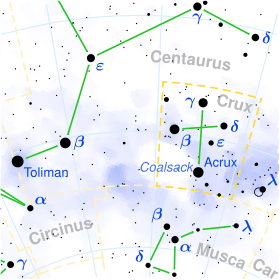DL Crucis

| |
| Observation data Epoch J2000 Equinox J2000 | |
|---|---|
| Constellation | Crux |
| Right ascension | 12h 14m 16.9255s[1] |
| Declination | −64° 24′ 30.662″[1] |
| Apparent magnitude (V) | 6.18[2] |
| Characteristics | |
| Spectral type | B1.5Ia[3] |
| U−B color index | −0.73[2] |
| B−V color index | 0.12[2] |
| Variable type | α Cygni[4] |
| Astrometry | |
| Radial velocity (Rv) | -10.50[5] km/s |
| Proper motion (μ) | RA: -5.62[1] mas/yr Dec.: 0.15[1] mas/yr |
| Parallax (π) | 0.80 ± 0.30[6] mas |
| Distance | approx. 4,000 ly (approx. 1,300 pc) |
| Absolute magnitude (MV) | −6.9[7] |
| Details | |
| Mass | 30[3] M☉ |
| Radius | 42[7] R☉ |
| Luminosity | 251,000[7] L☉ |
| Surface gravity (log g) | 2.50[3] cgs |
| Temperature | 20,100[3] K |
| Rotational velocity (v sin i) | 43[3] km/s |
| Other designations | |
| Database references | |
| SIMBAD | data |
DL Crucis is a variable star in the constellation Crux.
Visibility
DL Crucis has a visual apparent magnitude of 6.3 so it is just visible with the unaided eye in dark skies.[8] It lies in the small southern constellation of Crux, halfway between η Crucis and ζ Crucis and close to the constellation's brightest star α Crucis. This area of sky lies within the Milky Way and close to the Coalsack Nebula.
Properties
DL Crucis has a spectral type of B1.5 Ia, making it a luminous blue supergiant with a temperature over 20,000 K and 251,000 times as luminous as the sun.[7] It has a radius around 42 times,[7] and a mass 30 times that of the Sun.[3]
Variability
In 1977 DL Crucis, then referred to as HR 4653, was being used as a comparison star to test the variability of δ Crucis. δ Crucis turned out to be constant relative to several other stars, but the difference in brightness between it and HR 4653 changed by 0.02 magnitude.[9] It was considered likely to be a variable with a period longer than seven hours.[10]
Hipparcos photometry showed that DL Crucis was varying by up to 0.04 magnitude with a main period of 2 days 21 hours It was classified as an α Cygni variable.[11] Shortly afterwards it received its variable star designation of DL Crucis.[12]
A later detailed statistical analysis of the same data found periods of 3.650 and 3.906 days, as well as a first harmonic pulsation, with a maximum brightness range of 0.11 magnitudes.[7]
References
- 1 2 3 4 Van Leeuwen, F. (2007). "Validation of the new Hipparcos reduction". Astronomy and Astrophysics. 474 (2): 653. arXiv:0708.1752
 . Bibcode:2007A&A...474..653V. doi:10.1051/0004-6361:20078357.
. Bibcode:2007A&A...474..653V. doi:10.1051/0004-6361:20078357. - 1 2 3 Schild, R. E.; Garrison, R. F.; Hiltner, W. A. (1983). "UBV photometry for southern OB stars". The Astrophysical Journal Supplement Series. 51: 321. Bibcode:1983ApJS...51..321S. doi:10.1086/190852. ISSN 0067-0049.
- 1 2 3 4 5 6 Fraser, M.; Dufton, P. L.; Hunter, I.; Ryans, R. S. I. (2010). "Atmospheric parameters and rotational velocities for a sample of Galactic B-type supergiants". Monthly Notices of the Royal Astronomical Society. 404: 1306. arXiv:1001.3337
 . Bibcode:2010MNRAS.404.1306F. doi:10.1111/j.1365-2966.2010.16392.x. ISSN 0035-8711.
. Bibcode:2010MNRAS.404.1306F. doi:10.1111/j.1365-2966.2010.16392.x. ISSN 0035-8711. - ↑ Samus, N. N.; Durlevich, O. V.; et al. (2009). "VizieR Online Data Catalog: General Catalogue of Variable Stars (Samus+ 2007–2013)". VizieR On-line Data Catalog: B/gcvs. Originally published in: 2009yCat....102025S. 1: 02025. Bibcode:2009yCat....102025S.
- ↑ Gontcharov, G. A. (2006). "Pulkovo Compilation of Radial Velocities for 35 495 Hipparcos stars in a common system". Astronomy Letters. 32 (11): 759–771. Bibcode:2006AstL...32..759G. doi:10.1134/S1063773706110065. ISSN 1063-7737.
- ↑ Gaia Collaboration (2016). "VizieR Online Data Catalog: Gaia DR1 (Gaia Collaboration, 2016)". VizieR On-line Data Catalog: I/337. Originally published in: Astron. Astrophys. 1337. Bibcode:2016yCat.1337....0G.
- 1 2 3 4 5 6 Lefever, K.; Puls, J.; Aerts, C. (2007). "Statistical properties of a sample of periodically variable B-type supergiants. Evidence for opacity-driven gravity-mode oscillations". Astronomy and Astrophysics. 463 (3): 1093. Bibcode:2007A&A...463.1093L. doi:10.1051/0004-6361:20066038.
- ↑ Bortle, John E. (February 2001). "The Bortle Dark-Sky Scale". Sky & Telescope. Sky Publishing Corporation. Retrieved 28 June 2014.
- ↑ Balona, L. A. (1977). "A search for Beta Canis Majoris stars". Royal Astronomical Society. 84: 101. Bibcode:1977MmRAS..84..101B.
- ↑ Jakate, S. M. (1979). "A search for Beta Cephei stars. III - Photometric studies of southern B-type stars". Astronomical Journal. 84: 552. Bibcode:1979AJ.....84..552J. doi:10.1086/112448.
- ↑ Waelkens, C.; Aerts, C.; Kestens, E.; Grenon, M.; Eyer, L. (1998). "Study of an unbiased sample of B stars observed with Hipparcos: The discovery of a large amount of new slowly pulsating B stars". Astronomy and Astrophysics. 330: 215. Bibcode:1998A&A...330..215W.
- ↑ Kazarovets, E. V.; Samus, N. N.; Durlevich, O. V.; Frolov, M. S.; Antipin, S. V.; Kireeva, N. N.; Pastukhova, E. N. (1999). "The 74th Special Name-list of Variable Stars". Information Bulletin on Variable Stars. 4659: 1. Bibcode:1999IBVS.4659....1K.